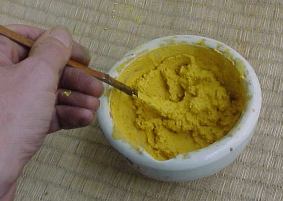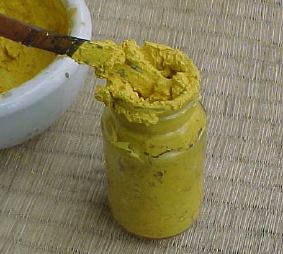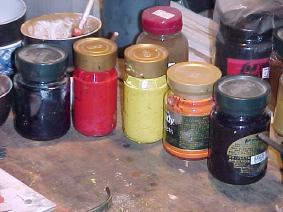Preparing Powder Pigments ... (entry by David Bull)
The idea of keeping a selection of pigments stored in 'paste' form in an alcohol/water mix is discussed in 'One-Point Lesson' #6 in another section of this Encyclopedia. Here's how it works ...
Here are some powder pigments from Matsuyoshi Enogu Shop in Tokyo. They are 500gm packs of the type of pigment known in Japanese as 'ganryo'.

The packs do not contain smooth finely-grained powder, but a jumble of broken pieces and lumps. The first step is to put some into a mortar and grind down the worst of the lumps:

Keep at it until it's fairly smooth ... say nothing larger than coarse sand ...

Then pour in a 50/50 mix of alcohol and water, enough to make it 'pasty'. I use pure alcohol from the pharmacy, but most Japanese traditional printers use o-saké.

Once your paste is ready, spoon it into a jar that has a good tightly-fitting lid. The jars I use originally contained freeze-dried coffee ...

Here, in this next photo, is my main selection of pigments; from the left:
- gunjo (prussian blue)
- hon yoko (a type of carmine)
- shin seki ei (a basic yellow)
- shu (vermillion)
- hon-ai (indigo)
Together with sumi (black), these will combine to form pretty much any colour I need in my prints.

Pigments stored this way are a snap to use - you just spoon dabs of the ones you need into a cup, blend them to make the colour you want, and then add water until you have the density that suits the job at hand. Because the pigments are pre-dissolved, it is a moment's work to adjust the colour with the addition of a dab more of pasty pigment from the appropriate jars.